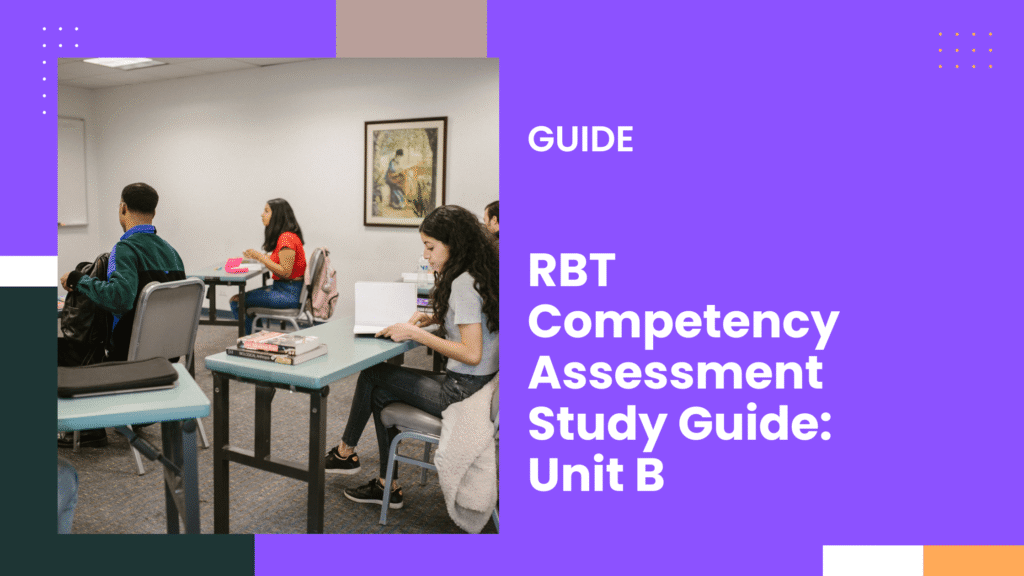
RBT Competency Assessment Study Guide – Our ultimate guide breaks down every skill you need—measurement, behavior reduction, professionalism—and gives you insider tips to crush your exam.
In the field of Applied Behavior Analysis (ABA), assessments aren’t just paperwork—they’re your blueprint.
As a Registered Behavior Technician (RBT), your role in conducting and supporting assessments is foundational to every individualized plan you help implement.
Unit B of your RBT Competency Assessment focuses on this critical function: how to identify what motivates your client, what skills they already have, and what environmental factors may be triggering behaviors.
| RBT Competency Assessment | Details |
|---|
| Purpose | Practical evaluation to demonstrate RBT skills across key behavioral domains |
| Number of Tasks | 20 tasks covering measurement, assessment, skill acquisition, behavior reduction, professionalism |
| Assessment Methods | Direct client work, role-play, interviews; at least 3 tasks must be demonstrated with a client |
| Administered By | Usually a BCBA or supervised assistant assessor |
| Duration | Typically 1 to 3 hours |
| Locations | Clinics, client homes, schools, or remote via video conferencing |
| Timing | Must be completed after 40-hour training and within 90 days before RBT exam application |
| Outcome | Successful completion leads to readiness for the final RBT certification exam |
B-1: Conduct Preference Assessments
Your first task in this unit is all about figuring out what your client actually cares about, because no intervention will work without motivation.
You’ll learn three core types of preference assessments:
- Single-Stimulus (Successive Choice): You present one item at a time and see if your client engages and is dealt with for learners with limited communication skills. Example: You offer a toy car, and the child plays with it. Next, you offer bubbles, and they show no interest. You note the difference.
- Paired-Stimulus (Forced Choice): Two items are presented, and the client picks one. This is great for building a preference hierarchy (e.g., Goldfish > bubbles > crayons). Example: When given a choice between a puzzle and a lollipop, the child consistently chooses the lollipop.
- Free Operant: Let the client explore a variety of items freely, and you observe what they choose and how long they engage with each.
- Multiple Stimulus Without Replacement (MSWOR):
The selected item is not returned after each trial, which allows you to quickly rank several items in order of preference.
Example: A child chooses bubbles first, a toy second, and music last, giving you a quick top-three reinforcer list.
Without a reliable preference assessment, even the best teaching strategies can fall flat. It’s not about what you think is rewarding—it’s about what the learner finds valuable.
For example, a student who refuses to do math worksheets might suddenly participate enthusiastically if offered five minutes of tablet time afterward. That insight starts with your assessment.
B-2: Assist with Individualized Assessment Procedures
The next step is where your test supports more formal evaluations, often led by your supervising BCBA, and they help determine the client’s current level of functioning across various skill domains.
You may assist with:
- Curriculum-Based Assessments (e.g., ABLLS-R, VB-MAPP): It assesses language, social, and daily living skills.
- Developmental Assessments: Compare your client’s developmental age versus chronological age.
- Social Skills Inventories: Reveal strengths and deficits in peer interaction, communication, and play.
You can help by gathering materials, prompting responses, collecting data, or even recording video for later review. Your job is to make sure assessments run smoothly and data stays clean.
Say you’re working with a 5-year-old with limited verbal communication.
You assist in administering VB-MAPP by presenting picture cards and recording whether the child can label each item.
Whatever data you help get will assist the BCBA in targeting expressive language goals.
B-3: Assist with Functional Assessment Procedures
When a client engages in challenging behavior, your role is to help figure out why.
That is where the functional assessment comes in.
The Functional Assessment Procedure teaches you to assist with:
- Indirect Assessments: You might gather information through parent interviews or questionnaires (e.g., Motivation Assessment Scale).
- Descriptive Assessments: This type of assessment involves direct observation using tools like ABC data sheets—documenting Antecedent, Behavior, and Consequence.
- Functional Analyses (under supervision): In some cases, you’ll also need to observe structured sessions where conditions are manipulated to test behavioral hypotheses.
Let’s take the help of an example,
Imagine you’re working with a teenager who frequently leaves their classroom.
By collecting ABC data over several days, you notice it always happens after a difficult math lesson.
The data suggests escape from demand might be the function, helping the BCBA craft more effective interventions.
Why Unit B Deserves Your Attention
Assessment isn’t a checklist—it’s the foundation for ethical and effective behavior change.
If you master this unit, you’re doing more than prepping for the RBT exam—you’re also learning how to deliver client-centered, data-driven care that actually works.
Personally, my advice for you is to focus on as you study:
- Know the types of preference assessments and when to use each.
- Understand how to assist respectfully and accurately in individualized assessments.
- Be confident in your role, observing, recording, and contributing to functional behavior assessments.
And lastly, trust your instinct and guts if necessary cause that can be the last resort sometimes.
